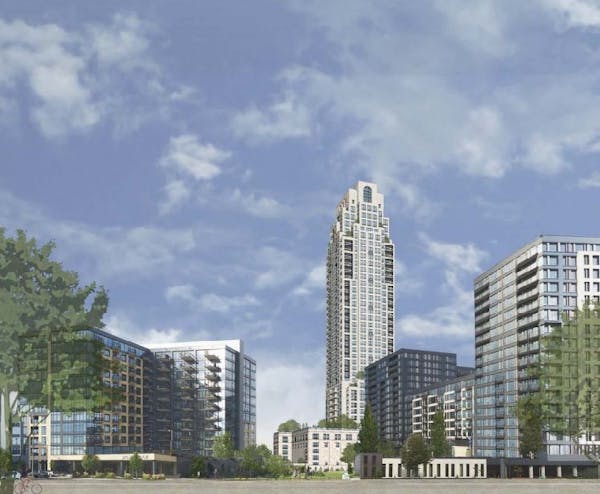A Hail Mary football pass from U.S. Bank Stadium, Ryan Cos. wants to build a 25-story apartment tower to complete its massive five-block redevelopment around the stadium.
Ryan Cos. has proposed a 345-unit apartment building next to the Mills Fleet Farm parking ramp on the slim southern half of the block along 4th Street between Park and Chicago avenues close to the Vikings stadium.
The new plans are a far cry from Ryan's earlier vision to build an office complex on the property dubbed the Block One site.
The plans were made public Friday in city documents. The project is scheduled to be discussed at the Nov. 15 Planning Commission committee meeting as well as at the Nov. 13 meeting of the Downtown Minneapolis Neighborhood Association.
Following city approvals, Ryan Cos. expects to start construction in mid-2019.
"We have spent the last couple of years marketing the site as an office tower but have not found market support for a project anchor," said Tony Barranco, senior vice president of real estate development at Ryan Cos., in a statement. "The demand for housing continues to be strong and with this outstanding location, we feel this will be a successful final step in our Downtown East five-block development."
As part of the $588 million build out of the five blocks surrounding the Vikings stadium, Ryan Cos. developed most of the core of what is branded as East Town: the 17-story twin Wells Fargo towers, the Edition apartment complex, the Radisson Red hotel, its own Millwright office building, and the Commons park. Ryan Cos. also built the six-level Mills Fleet Farm parking ramp, which is owned by the Minnesota Sports Facilities Authority.
The East Town district, which encompasses the neighborhoods of Downtown East and Elliot Park, has rapidly developed after the stadium and much of the surrounding major development led by Ryan Cos. was finished within the last couple of years.
In addition to a flurry of new residential construction, the Armory parking garage reopened as an event center, and the area's first grocery, Trader Joe's, opened along Washington Avenue S. Kraus-Anderson built a new headquarters, filling out the block with an apartment complex, hotel and brewery.
"The momentum in East Town is off the charts," Barranco said. "When we started our Downtown East project, some said that we were on the fringe of downtown. Now surrounded by new retail, grocery, hotels and other amenities, this site is in the middle of everything."
The Block One building itself would be more than 300,000 square feet and mostly occupy the skinny, vacant liner parcel next to the garage. The building is actually 24 habitable floors with the top floor containing mechanical systems. The units would offer a mix of micro, studio, one- and two-bedroom apartments and penthouses. One of the building's amenities would be a rooftop pool deck. The building would be connected to the skyway system and have 150 internal parking stalls.
Some of the balconies appear to overhang the ramp. Ryan Cos. has the air rights to develop the liner parcel and the air rights above the parking ramp, said Minneapolis spokesman Casper Hill. Any sale proceeds from the development would go to the city, he said.
In 2016, Ryan Cos. unveiled plans to build a 17-story office tower partly on top of the ramp, but the development company failed to get an office tenant to serve as the main anchor. Ryan Cos. had also struggled to secure office tenants in its nearby Millwright office tower where it was the sole occupant for more than a year before announcing this summer that digital healthcare company Rally Health would move to the building.
The change in the tower makeup from office to rentals is reflective of the overall Twin Cities real estate market. There has been a frenzy of new apartment-development proposals as vacancy rates remain low with the average apartment vacancy rate in the Twin Cities at 2.2 percent by the end of June, according to Marquette Advisors.
On the flip side, downtown Minneapolis has a significant amount of vacant office space on the market with many companies consolidating their space and some choosing to build their own single-tenant offices. According to the summer Compass report from Cushman & Wakefield, Class B space vacancy was 26.3 percent and Class A vacancy was at 14.5 percent in downtown.
Nicole Norfleet • 612-673-4495
Twitter: @nicolenorfleet
